The Progressive Publishing team is pleased to once again bring you the Top 25 most well-read articles. This list reflects content published from Oct. 1, 2015 through Sept. 30, 2016 and is based on Google Analytics.
When possible, our team asked follow-up questions from the authors and dairy producers featured.
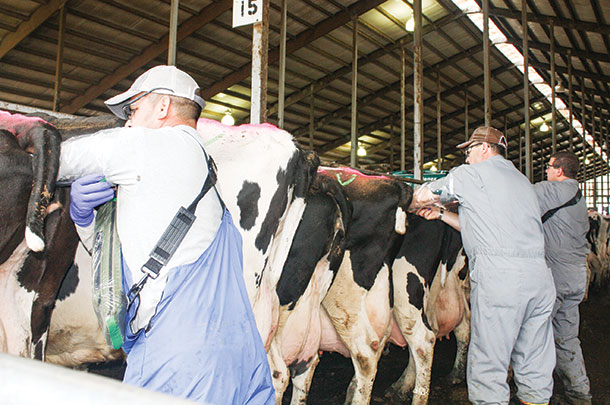
1. Two producers share their secrets to a 30 percent pregnancy rate
Published: Jan. 28, 2016 Extra e-newsletter
Summary: Reaching a 30,000-pound herd average and 30 percent pregnancy rate takes a lot of management focus for a dairy farm. At a presentation last winter, dairy producers from Michigan and Wisconsin outlined their breeding programs and other areas on their farm that they attribute to reproductive success.
Q. What have you done to enhance reproduction or milk production on your farm in the past year?
“We have continued to make improvements in both production and reproduction in our dairy.
“Currently, our cows are averaging 100 pounds per day with a 3.8 percent butterfat, 3.06 percent protein, along with a 55,000 somatic cell count average for the year. We attribute our continued increases in milk production to improved forage quality as well as different seed selection for higher-quality corn silage.
We have tweaked our fresh cow protocols to ensure a smooth transition from dry cows to the breeding pen with improved milk starts. We have also placed more emphasis on pounds of milk in our genomic selection index, which is based on Net Merit.
“In regards to reproduction, we have had continued improvements with our pregnancy rate up to 40 percent on a 54 percent conception rate along with a 74 percent heat detection rate. We have now had a full year of using a double shot of prostaglandins in our Ovsynch protocols, which has showed improvements in our conception rate.
We also have placed more selection emphasis on our heifers for Net Merit and Daughter Pregnancy Rate. We have been testing every heifer genomically and culling the bottom 15 percent with all animals having to be at least 400 Net Merit dollars to stay in the herd. We feel our continued pressure on genetics has led to continued increases in both breeding and milk production.”
—Brian Schilling, Schilling Farms, LLC in Darlington, Wisconsin
Editor’s note: We did not receive a response from Jeff Shriver in Michigan.
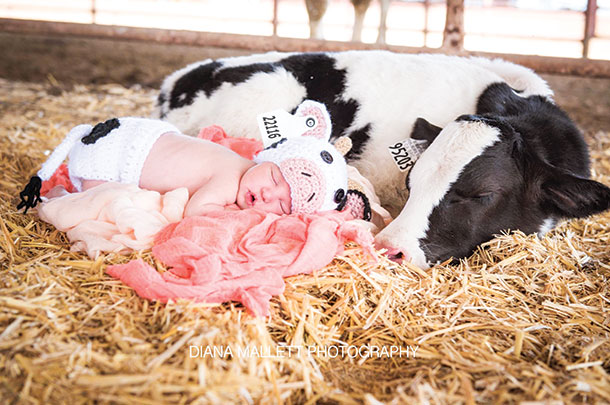
2. Sweet photo of newborn calf and baby goes viral
Published: May 11, 2016 Extra e-newsletter
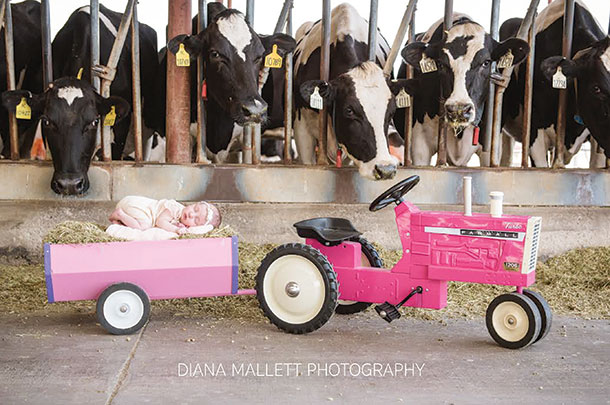 Summary: This popular post profiled photographer Diana Mallett and a special photo shoot she did at McClintock Dairy in Coolidge, Arizona.
Summary: This popular post profiled photographer Diana Mallett and a special photo shoot she did at McClintock Dairy in Coolidge, Arizona.
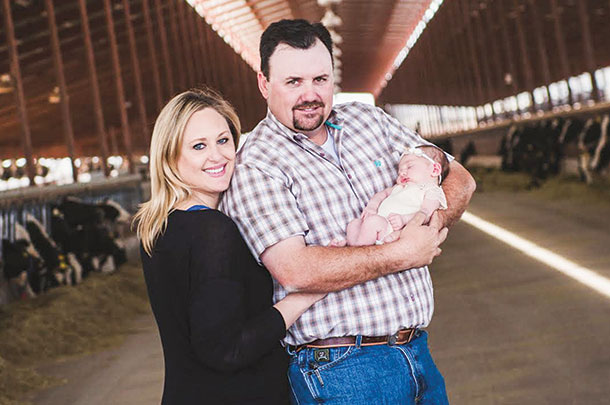
The shoot featured newborn Emmie Boyle, daughter of Rob and Destiny, and one of the dairy’s newest baby calves. The photos went viral, much to the surprise of the photographer and family.
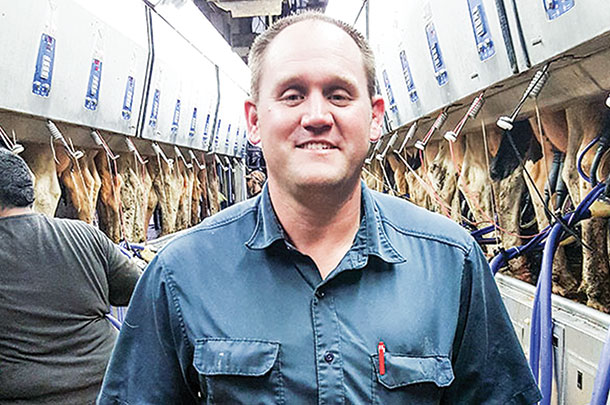
3. Dairy farmer recalls shooting rampage one year ago
Published: June 28, 2016 Extra e-newsletter and Sept. 12, 2016 print issue
Summary: This article follows up with Zach Myers, a North Carolina dairyman who was shot in the neck in June 2015. It retells the experiences leading up to the almost fatal incident and Myers’ recovery. He returned to full-time work on his 900-cow herd this year.
Q. Since recovering from the shooting, what do you find you are more grateful for during the Christmas season and the start of a new year than you were before a brush with death?
“With the holiday season here, I am thankful to still be alive after the shooting over a year ago. I am most thankful for my family and the ability to continue to watch my three children grow into wonderful people.
I am also thankful to be involved in an industry that is more like a huge family. Thank you, to all of you who have kept me in your thoughts and prayers since the shooting. Unfortunately, I cannot say that I am fully recovered, but I continue to improve and am certainly grateful for that.”
—Zach Myers, North Carolina dairy farmer
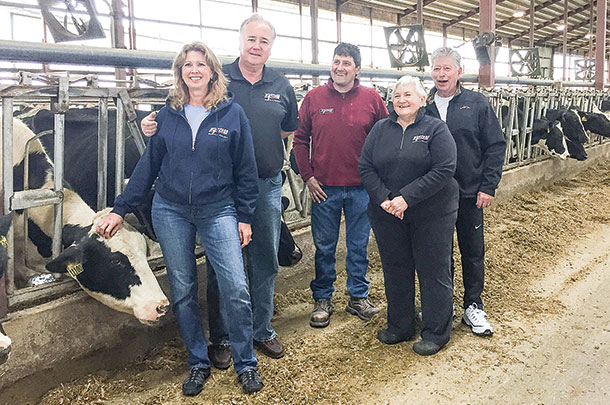 4. Kinnard Farms’ new facility keeps it all ‘under one roof’
4. Kinnard Farms’ new facility keeps it all ‘under one roof’
Published: Nov. 7, 2015 print issue
Summary: Last year, the Kinnard family began milking in a brand-new 100-stall rotary parlor and built a state-of-the-art cross-ventilated barn for 7,000 cows in Casco, Wisconsin. The enclosed barn is one-third of a mile long, bringing each step of their cows’ adult life under one roof.
Q. With over a year into your new facility, have your expectations been met, including your goal to milk 700 cows per hour?
“It’s going better than we thought. Things are really falling into place. We’ve gotten through the first lactation with animals we purchased for the expansion. In the parlor, we’ve found that our goal of milking 700 cows per hour is very doable, and we can go as high as 725 comfortably."
"With our cross-ventilated barn, I’m convinced that there is no such thing as heat stress. We saw zero change in production and reproduction, and never saw a drop in intakes over the summer. I’m also quite impressed with the volume reduction of manure. There’s a whole lot less manure to haul per cow.”
—Lee Kinnard, Wisconsin dairy farmer
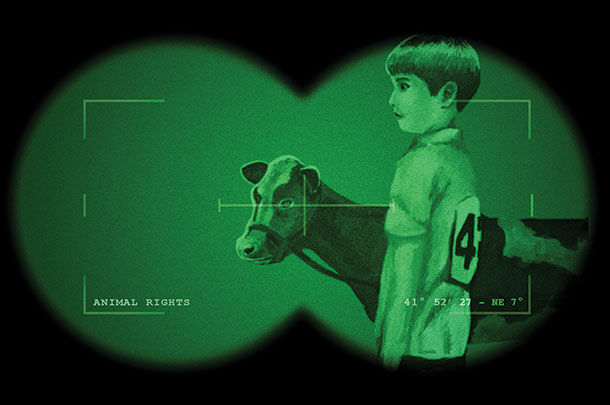 5. Animal rights activists target fairs and livestock shows
5. Animal rights activists target fairs and livestock shows
Summary: This year, youth fairs and livestock events across the country were caught in the crosshairs of activists’ protests and demonstrations, even in the most rural communities.
Hannah Thompson-Weeman from the Animal Ag Alliance said that efforts like these are becoming common tactics used by anti-agriculture groups to draw media attention to their messages. She encouraged youth livestock exhibitors and their parents to have an action plan in place in case they come face-to-face with animal rights activists at their shows and fairs.
Q.How widespread were animal rights activist demonstrations this past year? How do you think dairy and livestock producers handled these situations?
“This year saw several high-profile animal rights activist demonstrations at events ranging from the opening ceremony of the Pennsylvania Farm Show in January to a Bernie Sanders rally in May to a professional baseball game in September."
"One prominent group took credit for more than 10 major disruptions in 2016 that caught media attention. Activist leaders speaking at animal rights conferences this summer urged more of these protests, stating all public events ‘need to be interrupted and shut down’ and ‘your local fair, circus, rodeo … go and protest.’"
“Fortunately, most of these incidents took place at major events with law enforcement or security present who quickly stepped in to handle the situation, preventing altercations between activists and event attendees. We should continue to be mindful of this threat and ensure that we have proper security and plans in place for activist activity at fairs and other agricultural events.”
—Hannah Thompson-Weeman, Communications Director, Animal Agriculture Alliance
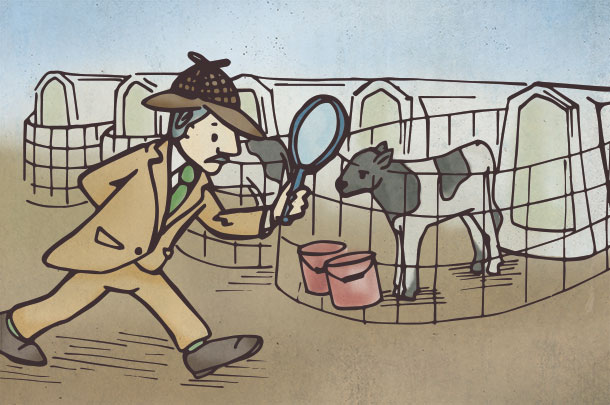
6. Myth-busting nutritional scours: To treat or not to treat
Published: June 8, 2016 Extra e-newsletter
Summary: In this article, Tom Earleywine debunked six myths regarding scours and calf care.
Q.What are the top three things to keep in mind when feeding electrolytes to a scouring calf?
“The top three things to keep in mind are:
1. Diagnosis: When it comes to young calves fed milk or milk replacer, loose manure is a common occurrence. When feeding a full-potential diet, manure may appear loose, but the calf may not be sick.
Determine if the calf is showing additional signs of illness or if loose manure is simply because the calf is consuming a high level of nutrition in a liquid diet. If electrolytes are needed, monitor the calf’s response throughout treatment until fully recovered.
2. Management: Proper management and care are essential when feeding electrolytes. During treatment, calves should continue to be fed milk or milk replacer in addition to electrolytes.
Electrolytes should be mixed with quality, low-sodium water and should never be mixed into milk or milk replacer. Additionally, equipment in contact with electrolytes or the calf should be properly cleaned and sanitized.
3. Product: With a multitude of electrolytes on the market, it can be difficult to choose the best product for your calves. Look for a product that meets national guidelines for a commercial oral electrolyte solution that is palatable to the calf.
To get the most effective treatment, electrolytes should contain an alkalizing agent to reduce acidosis, glycine to aid absorption, dextrose for energy, malic acid to reduce D-lactic acidosis and zinc to aid in gut healing.”
—Tom Earleywine, director of nutritional services with Land O’Lakes Animal Milk Products
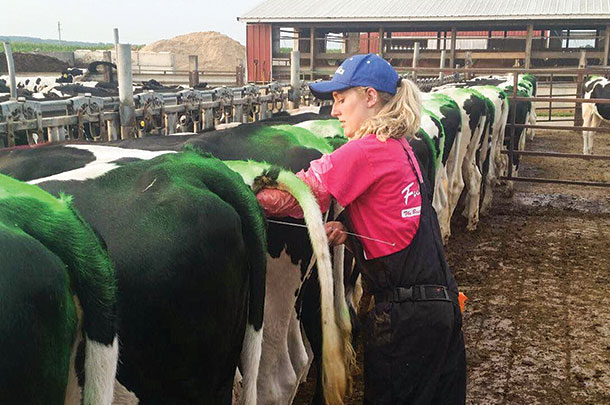 7. Getting cows bred: How three dairies get it done
7. Getting cows bred: How three dairies get it done
Published: Oct. 1, 2015 Extra e-newsletter and Oct. 19, 2015 print issue
Summary: In this article, these three dairy managers shared the protocols and methods they use to achieve outstanding reproductive performance benchmarks.
Progressive Dairyman followed up with Jesse Ayers of Ayers Farms Inc. in Ohio, and Aubrey (Lettinga) Van Lann of Walnutdale Dairy in Michigan to see what, if anything, has changed with their respective breeding protocols since the article was written.
Q. Since this article was published, have you made any major changes to your breeding protocols? If so, what and why?
“We’ve run consistent numbers, within a couple of points. Our breeding protocols have stayed the same, but we are always trying to do better on transition cows. We try to make sure cows are on a close-up diet for at least three weeks (anionic salt diet).
We also detect as many twins as possible using ultrasound and move these cows directly into close-up pen for all dry period.”
—Jesse Ayers, part family owner, Ayers Farms Inc.
“We haven’t changed anything as far as protocols; the numbers are still holding out. We think cow health has a lot to do with it. In the past, we had transition cow problems, and that had affected reproduction."
"We have meetings every few months to go over numbers. By doing this, we are able to catch any problems and correct them before they get out of control.”
—Aubrey (Lettinga) Van Lann, herd manager, Walnutdale Farm
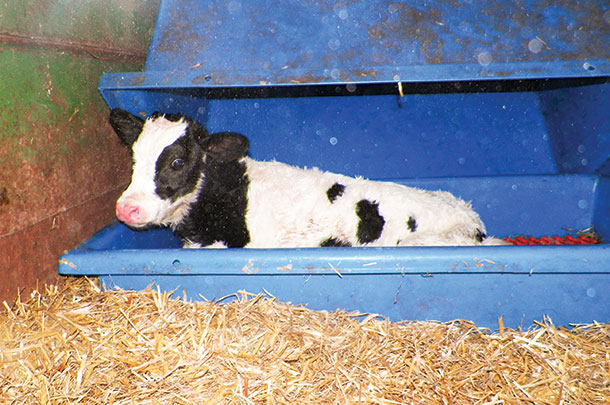 8. Heating box does more than just warm calves
8. Heating box does more than just warm calves
Published: Jan. 21, 2016 Extra e-newsletter and Feb. 7, 2016 print issue
Summary: Pennsylvania dairy farmer Kelli Woodring shared in this blog post how adding a calf warming box to their winter calf protocols led to healthier calves with fewer navel issues.
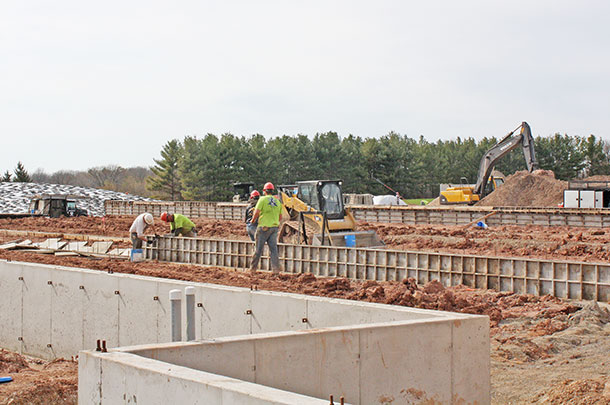
9. How much will that new barn cost you?
Published: Jan. 15, 2016 Extra e-newsletter
Summary: At the beginning of the year, the University of Wisconsin Extension Dairy Team released an informative paper estimating whole-project costs for calf, heifer and cow barns and various milking systems on a per-unit basis, as well as costs for building materials like frames, concrete, pens and stalls and more.
David Kammel, an agriculture building design professor with the university, led the development of this paper.
Q. What type of building and construction projects have you seen the most of with dairies you work with in 2016?
“The top three facility designs I have been asked to develop are:
1. New freestall barn for 120 to 150 lactating cows in two pens as phase one of a master farmstead plan. The capacity to integrate an automatic milking system in the future is usually a condition of the design layout.
2. New transition cow barn for herds that have expanded lactating cows and now want to do a better job at transition cow management. Common set up includes pens for far-off dry cows/springing heifers, close-up cows/heifers, maternity pens, hospital pen and fresh cow pen.
3. New calf barn for calves from birth to 6 months old. Two management schemes are common. One is a calf barn design with individual calf pens and transition group pens, and the second is a barn design with group-fed calves in pens of 12 to 20 calves per pen and two to four pens depending on herd size.”
—David Kammel, professor, University of Wisconsin
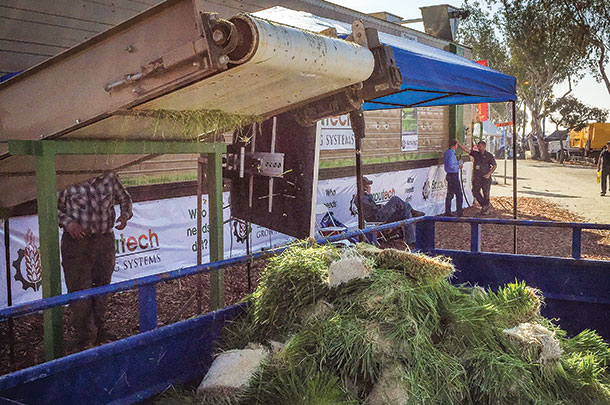
10. Cool stuff we saw at World Ag Expo 2016
Published: Feb. 24, 2016 Extra e-newsletter and March 12, 2016 print issue
Summary: It’s no surprise that our annual “Cool stuff” articles from World Ag Expo and World Dairy Expo once again made the Top 25 list.
This year’s WAE recap featured the show’s record attendance, a portable lift gate, advancements in fodder systems and plenty of drones. Stay tuned to find out what’s set to unveil at the 2017 show.
 11. Drone wars: What's the law on shooting trespassing drones?
11. Drone wars: What's the law on shooting trespassing drones?
Published: March 24, 2016 Extra e-newsletter and April 19, 2016 print issue
Summary: Much of the agricultural community’s conversation surrounding the use of “drones” concerns the positive aspects of inspecting cropland or viewing grazing cattle. However, drone technology creates the potential for activists to spy on concentrated feeding operations.
Use of drones to spy on farming operations is an area of “unsettled law.” The law has fallen behind the technology, leading many people to question, or incorrectly assume they understand, how private property rights and the use of commercial drones will co-exist.
One thing is clear: If you suspect an activist is spying, don’t blow the drone out of the sky. Criminal charges have already been filed in drone shooting incidents in several states.
Q. How did the FAA’s new UAS Rule impact agricultural use of drones?
“While the law remains unsettled regarding private property rights and unmanned aircraft systems (UAS or drones) flying overhead, the regulations related to proper flying of drones have been finalized, published and are in effect. The Federal Aviation Administration (FAA) regulations make it legal, as of August, to use drones for commercial use in the U.S., provided these regulations are followed."
"Those persons operating drones are required to register their aircraft before their first flight. Additionally, the FAA regulations include rules for pre-flight issues like conducting safety inspections, in-flight issues such as where, when and how drones may be operated, and post-flight issues including requiring reports if incidents occur."
"This is an area where the law is rapidly changing, and both operators and landowners should be sure to keep up on the many changes likely to be coming in 2016.”
—Tiffany Dowell Lashmet, assistant professor and extension specialist in agricultural law with the Texas A&M AgriLife Extension Service
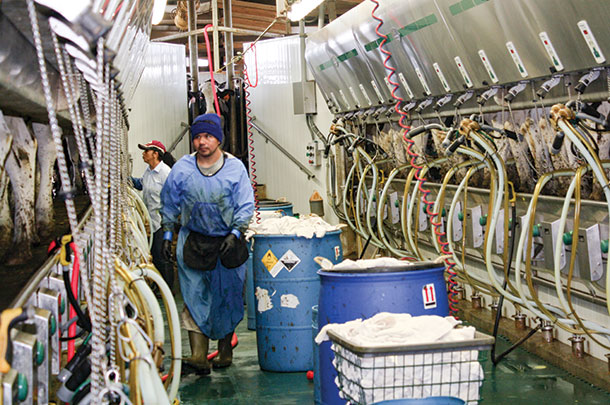
12. Six ways Grand View Dairy maintains a somatic cell count of 85,000
Published: Aug. 4, 2016 Extra e-newsletter and Oct. 1, 2016 print issue
Summary: Readers were interested to learn how herd manager Jackie Schnackel has maintained such a high level of milk quality for going on two years at the 1,200-cow dairy in Brillion, Wisconsin.
Q. Since this article was published, have you made any changes to your protocols? If so, what and why?
“We have made just a slight change. As stated in the article, we had previously seen very few cultures of Staph. aureus, but shortly after, we had two new herd cows with clinical mastitis that cultured with it, then a couple fresh heifers and a fresh cow.
So we have begun sampling and culturing all fresh cows (first-lactation and mature) for Staph. aureus. Since starting, we did find two others before they were in the milk herd. When we make a change like this, we will continue it for at least six months after the problem arises.
“I would recommend milking at the end of the milking and then culling them. But that is not necessarily what we do. We have a treatment protocol for first-lactation cows with Staph. aureus that has been pretty successful. These cows are kept in the last milking group, even though they have been treated and somatic cell count is very good.
When we can identify an individual quarter on a mature cow, we may try to dry just that quarter. Otherwise, we make a decision based on the overall health and status of the cow. Cows with Staph. aureus don’t get many other chances but will stay in the herd and be milked at the end of the milking until another condition arises and then be culled. Again, I would recommend selling them as soon as possible.”
—Jackie Schnackel, herd manager, Grand View Dairy
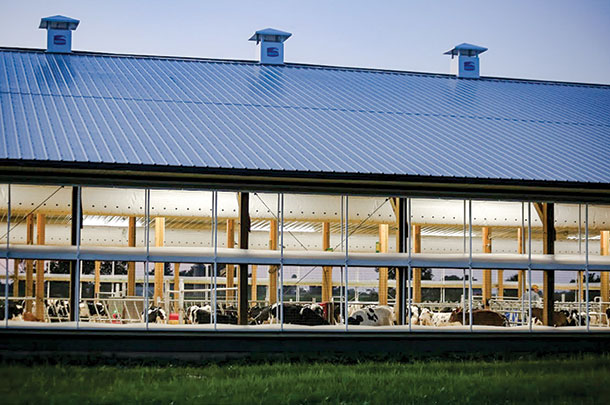 13. Pankratz family focus on youngstock positions farm for future
13. Pankratz family focus on youngstock positions farm for future
Published: Jan. 7, 2016 Extra e-newsletter and Jan. 19, 2016 print issue
Summary: The Pankratz family in central Wisconsin invested in new calf facilities and feeding systems to eventually grow their 120-cow herd to 400 milking.
For now, they use the new facility – completed in 2014 – to raise bull calves for feeder steers. The calf barn is equipped with automatic top and bottom curtains as well as temperature and rain sensors. The family also uses a CalfMom feeding system.
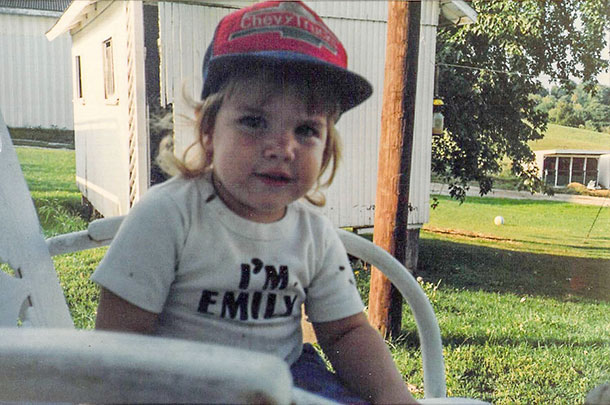
14. 10 signs you grew up on a dairy
Published: Aug. 22 Extra e-newsletter
Summary: Our staff had a lot of fun reminiscing about our childhoods on the dairy in order to compile this list. This fun piece was the brainchild of our 2016 editorial intern, Audrey Schmitz.
We received the following comment for this article online:
“In the ’70s we took scrapers and made roads in the manure on the concrete pad while the cows were milking, then rode our bikes, daring each other to see how fast we could ride before someone missed a curve and landed in the manure.”
—Paula Lehrer
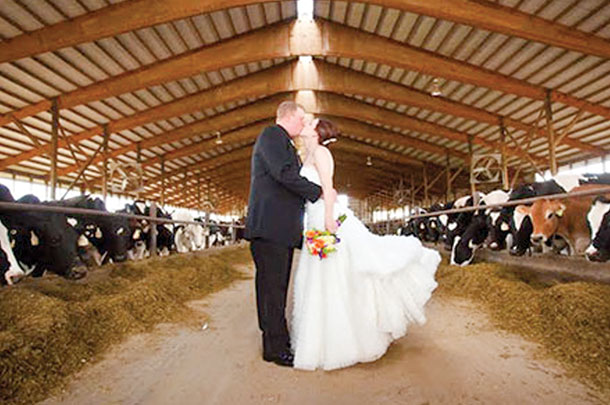 15. Wedding dos and don’ts for farm brides-to-be
15. Wedding dos and don’ts for farm brides-to-be
Published: June 17, 2016 Extra e-newsletter
Summary: Planning a 2017 farm wedding? Be sure to check this article for tips from brides who’ve been there. From picture-perfect backdrops to wedding day disasters, these dairywomen experienced it all.
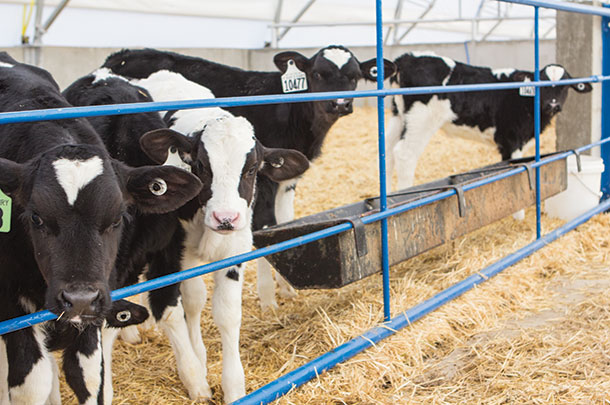 16. Indoor calf pen walk-throughs: What you need to look for
16. Indoor calf pen walk-throughs: What you need to look for
Published: Jan. 19, 2016 print issue
Summary: In the first of a two-part series, Anne Proctor identified several things to be aware of when performing a calf pen walk-through. Her tips provide calf managers and employees with a quick and simple way to assess calf health.
Q. Once you've identified a sick or potentially sick calf, what are the next steps you should take to get it on the road to recovery?
“Once you’ve identified a sick calf, review the symptoms you’re seeing to determine if you’re dealing with a scours event, a respiratory event or another issue. Check the calf’s temperature and treat according to the recommendations made by your veterinarian."
"If you do not already have protocols in place for treating sick calves, work with your veterinarian to develop a treatment plan. Continue to feed milk as long as the calf will drink on its own. Electrolytes help keep the calf hydrated and can be offered between milk feedings."
"If the calf is not drinking on its own, contact your veterinarian for more specific recommendations. Successful calf managers identify sick calves early in the disease process, treat promptly and work closely with their veterinarian.”
—Anne Proctor, dairy technical specialist, Agri-Nutrition Consulting
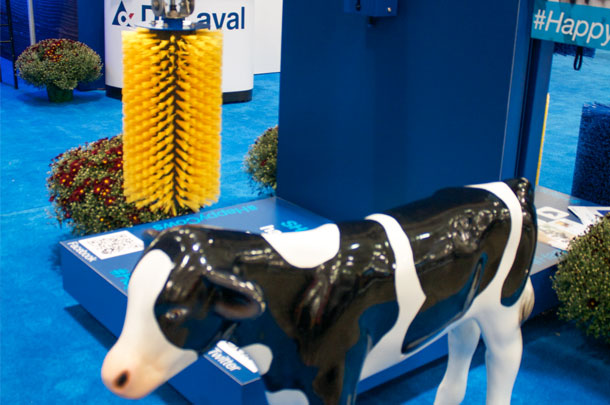
17. Cool stuff we saw at World Dairy Expo 2015
Published: Oct. 9, 2015 Extra e-newsletter and Oct. 19, 2015 print issue
Summary: Our highlights from the 2015 World Dairy Expo show included Vel’Phone’s calving detection device, Cargill’s feed artist, daily cheese flavors at the Badger Dairy Club’s booth and the screening of The Ivy League Farmer.
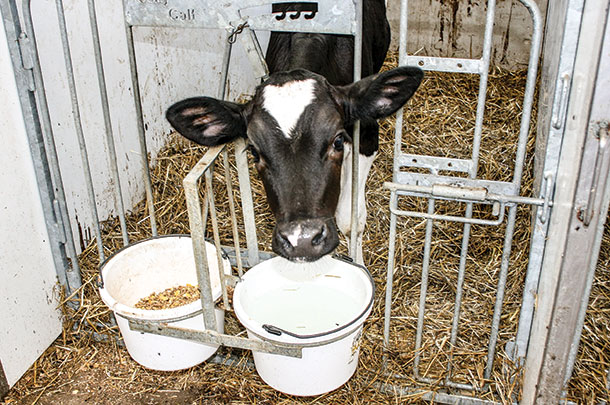 18. Feeding forage to calves: Is it necessary?
18. Feeding forage to calves: Is it necessary?
Published: Jan. 7, 2016 Extra e-newsletter and Jan. 19, 2016 print issue
Summary: Xavier Suarez and Alex Bach co-authored this article on whether dairy producers should feed forages to calves and what to look for in a forage. The article presents two approaches: feeding a high-quality, texturized starter and feeding forage along with a complete pellet starter.
Q. How soon should producers offer forage to their calves and how should it be presented to them?
“Chopped (about 1 inch in size) high-NDF grass forages (avoid legumes such as alfalfa) should be offered after the first week of life when starter is completely pelleted. Forage can be offered in a bucket placed next to the bucket containing the starter feed, but it can also be placed elsewhere in the hutch/pen."
"Mixing the chopped forage with the starter feed at less than 5 percent inclusion can also help to ensure calves eat both the starter and forage. When feeding high-quality, highly texturized starters, forage won’t be needed until one week after weaning.”
—Xavier Suarez, calf and heifer nutritionist, Provimi North America; and Alex Bach, department head ruminant production, Institute for Research and Technology in Agrifood

19. An Indiana dairyman finds a simpler way to feed
Published: May 7, 2016 print issue
Summary: This article features Tony Goltstein of Union-Go Dairy LLC in Winchester, Indiana, and his self-propelled mixer wagon. The first-of-its-kind wagon was on display at the 2015 World Dairy Expo.
Goltstein has been pleased with the benefits from the equipment purchase, including feed accuracy, shrink reduction and fuel savings. He does envision needing to upgrade at some point, and he plans to look at the custom mixer bin lid.
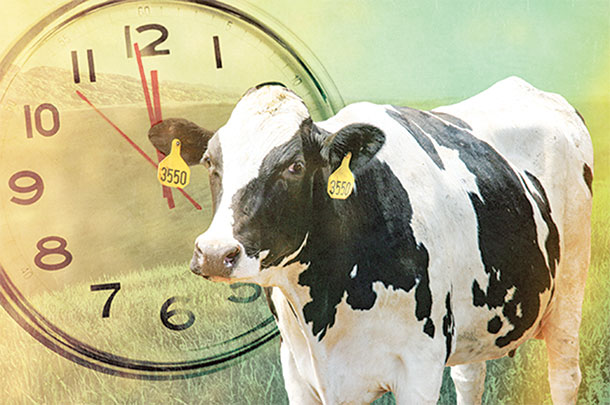
20. Your schedule or the cows’ schedule – which should you follow?
Published: Feb. 12, 2016 Extra e-newsletter and Aug. 25, 2016 print issue
Summary: This article was written from Dr. Kevin Harvatine’s presentation at the 2015 Penn State Dairy Cattle Nutrition Conference. He explained why cows like to do things at certain times – like eating, ruminating and sleeping – and how managing cows’ preferences can lead to consistent feed intake and increased milk production.
The article was translated into Spanish for a summer 2016 issue. Contact the office team if you’d like to obtain a copy of either the English or Spanish version of this article.
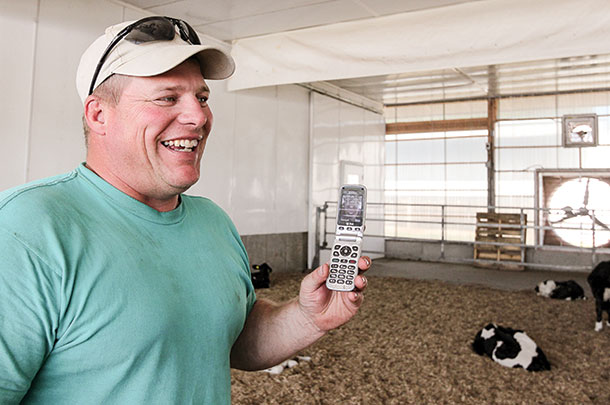 21. Consistency is name of game in new calf barn at Carlson Dairy in Minnesota
21. Consistency is name of game in new calf barn at Carlson Dairy in Minnesota
Published: Nov. 13, 2015 Extra e-newsletter
Summary: Despite still using a flip phone (at least as of late 2015), Chad Carlson in Pennock, Minnesota, is very tech-savvy when it comes to his calves. The 1,300-cow dairy completed a new calf facility building in 2014.
Carlson uses automatic feeders and tracks average daily gain. Carlson prefers to view data at the CalfMom unit, while calf barn manager Joyce Weber accesses the data from the computer and her smartphone.
22. Don’t breed too early
Published: April 19, 2016 print issue
Summary: Timing is everything, especially when it comes to the timing of insemination to give an embryo the best chance of survival. When cows are bred too early, sperm may die before the oocyte is ready to be fertilized.
However, activity monitors are showing us when cows should be bred for the best chance of pregnancy.
Q. As activity monitoring technology grows in use on dairies, what are a couple of tips for turning the data into an action plan to get more cows bred on time?
“I would emphasize the need to customize the settings of the system to each farm. The facilities layout and management influence cow behavior and, therefore, activity. This will minimize false positives, reduce labor and improve reproductive performance.
“Work with your veterinarian to design a protocol to integrate the use of the activity system in your reproductive management. It doesn’t need to be a complete either/or. I highly recommend breeding as many natural heats as possible because they have better conception than induced heats or ovulations, and then use a treatment protocol to work with animals that don’t cycle normally. If there are too many abnormal cycles, then it is time to work with your nutritionist.”
—Aurora Villarroel, application support manager, Americas West, Afimilk Ltd.
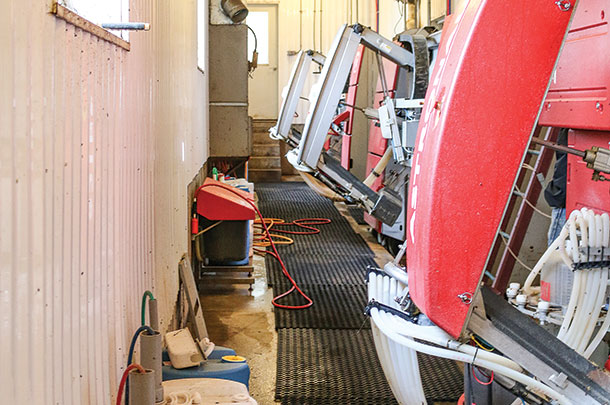
23. Why I chose robots: Scheer’s Dairy Farm LLC
Published: Nov. 7, 2015 print issue
Summary: The Scheer family was the first in the state to become a robotic dairy. They now milk about 150 cows with three robots. Rick Scheer says the only change he would make if he could rebuild would be to make the freestalls, alleys and crossovers bigger. He advises fellow dairy producers considering robots to leave room for expansion.
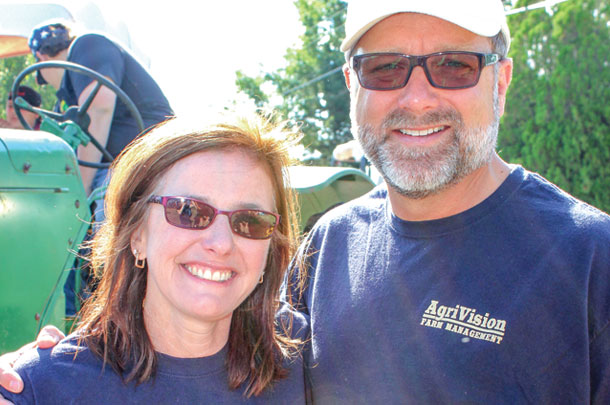 24. Donald, Cheri De Jong build multi-discipline dairy company
24. Donald, Cheri De Jong build multi-discipline dairy company
Published: July 1, 2016 print issue
Summary: Donald and Cheri De Jong have built a large dairy footprint in the panhandle of Texas. This article details how their aspirations and herd size grew from small to medium to large throughout their careers. They now look to build a multi-generation company.
Q. What are some of the New Year’s resolutions you have personally or for your dairy in 2017?
“As we look forward to 2017, we will continue to focus on building community for our fellow farmers. We hope to share our experience, lessons learned and innovations to continually strengthen the world of dairy farming."
"As the group of active dairy farmers in our country gets smaller each year, it becomes more important than ever that we support each other and continue to innovate an industry that’s given so much to us all.”
— Donald and Cheri De Jong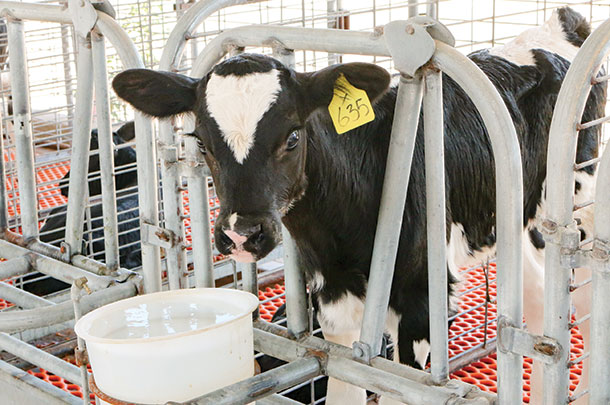
25. Stotz Dairy: Cleanliness is key for healthy calves
Published: Dec. 2, 2015 Extra e-newsletter and April 1, 2016 print issue
Summary: Jen Millican, calf manager at Stotz Dairy in Buckeye, Arizona, is committed to high-quality care for the dairy’s nearly 8,000 calves and heifers.
This feature details Millican’s protocols and explains how she achieved a decrease in mortality rate from 5 percent three years prior to currently less than 1 percent. ![]()
PHOTO 1: By focusing on reproduction, both J-Max Dairy and Schilling Dairy are able to achieve a 30 percent pregnancy rate with 30,000-pound herd averages. Photo by Peggy Coffeen.
PHOTO 2: This sweet photo of a newborn calf and a newborn baby asleep at the same time went viral across multiple media outlets.
PHOTO 3: Diana Mallett captured several other adorable photos, including this gem with the baby, Emmie, ‘riding’ in a pink wagon, pulled by a pink tractor.
PHOTO 4: Destiny Boyle, left, and her husband, Rob, knew they wanted a newborn photographer who would embrace a photo shoot in the barn. Photos by Diana Mallett.
PHOTO 5: One year later after a gunshot wound to the neck, Zach Myers has resumed dairying on his farm. Photo provided by Zach Myers.
PHOTO 6: Earlier this fall, the Kinnard family of Casco, Wisconsin, moved into their new facility, built to accommodate 7,000 cows at full capacity. The dairy is owned by siblings Lee, Rod and Jackie. Pictured from left to right: Jackie (Kinnard) and David Stewart; Lee; and Maureen and Rod Kinnard. Photo provided by Kinnard Farms Inc.
PHOTO 7:Illustration by Corey Lewis.
PHOTO 8: Illustration by Kristen Phillips.
PHOTO 9: By moving heifers into breeding pens sooner, Walnutdale Dairy is able to observe and track heats prior to first A.I., and the animals adjust better to their new group and headlocks. These changes have contributed to reducing the use of CIDRs on the heifers. Photo by Stephanie Skernivitz.
PHOTO 10: Kelli Woodring has found much success with a calf warming box. Photo by Kelli Woodring.
PHOTO 11: A new fact sheet from the University of Wisconsin can help you estimate dairy building costs. Photo by Peggy Coffeen.
PHOTO 12: Automated fodder systems take a step forward. Photo by Staff.
PHOTO 13: Shooting drones that fly over your property could potentially be seen as shooting an airplane in the eyes of the law and may lead to terrorism charges. Photo by Kevin Brown
PHOTO 14: At Grand View Dairy, milk quality is maintained with a consistent parlor routine and focus on cleanliness. Photo by Peggy Coffeen.
PHOTO 15: Thermostatically controlled curtains and LED lighting conserve energy and improve conditions. Photos by Sherry Bunting.
PHOTO 16: Editor Emily Caldwell discovered from a young age that helping out in the barn almost always resulted in manure-covered clothing. Photo provided by Emily Caldwell.
PHOTO 17: Ashley and Eric Kennedy of Bad Axe, Michigan, were married in October 2012 at a church in their community. They chose to have photos taken on Ashley's family farm after the ceremony, proving that regardless of location, the farm can always be a memorable part of your wedding day. Photo by Moments Captured by Vanessa.
PHOTO 18: Calves in an indoor pen. Photo by Mike Dixon
PHOTO 19: World Dairy Expo 2015. Photo by Staff.
PHOTO 20: Staff photo.
PHOTO 21: Indiana dairyman Tony Goltstein says a new self-propelled mixer wagon with attached defacer reduces wastage, labor and makes maintenance easier. Photos courtesy Tony Goltstein.
PHOTO 22: Staff photo.
PHOTO 23: Chad Carlson laughs that he doesn’t even text and still uses a flip phone, but he is an advocate of technology in milking and calf feeding. “If I can do it, anyone can,” he says. He chooses to view the calf data at the CalfMom unit, while Joyce Weber prefers to access it from her computer and smart phone. Photo by Sherry Bunting.
PHOTO 24: Leave room for expansion. Don’t box yourself in. Photo by Jenna Hurty
PHOTO 25: Donald and Cheri De Jong own and operate Natural Prairie Dairy, a 14,000-cow organic dairy in Hartley, Texas; Northside Farms, a 5,500-cow conventional Holstein dairy in Hartley, Texas; and Jersey Gold Dairy, a 2,800-cow Jersey dairy in Dalhart, Texas, with their families and employees. Photo provided by Donald De Jong.
PHOTO 26: Calves are bucket-trained with their first milk feeding at 2 days old. After that, they have constant access to water. At 3 days old, they also have access to starter. Photos by Jenna Hurty.



